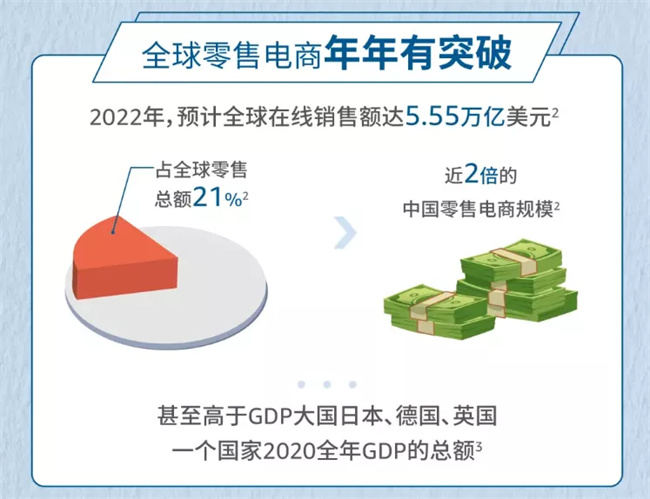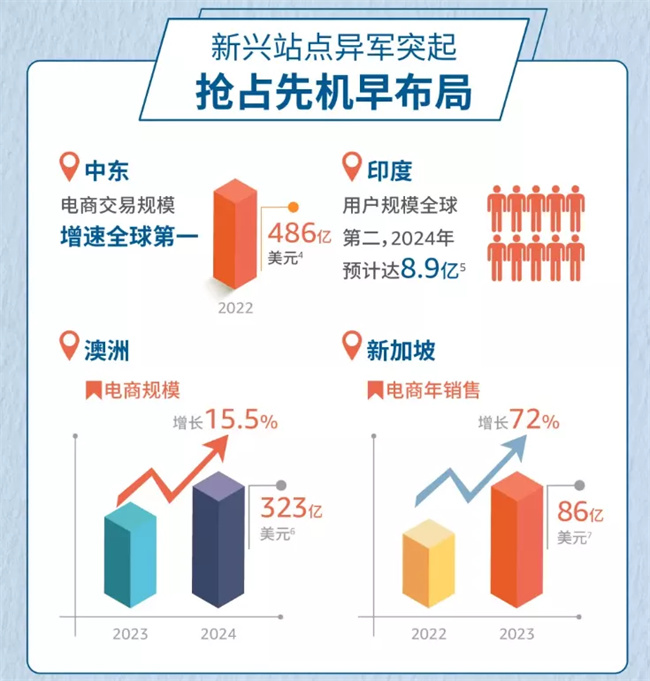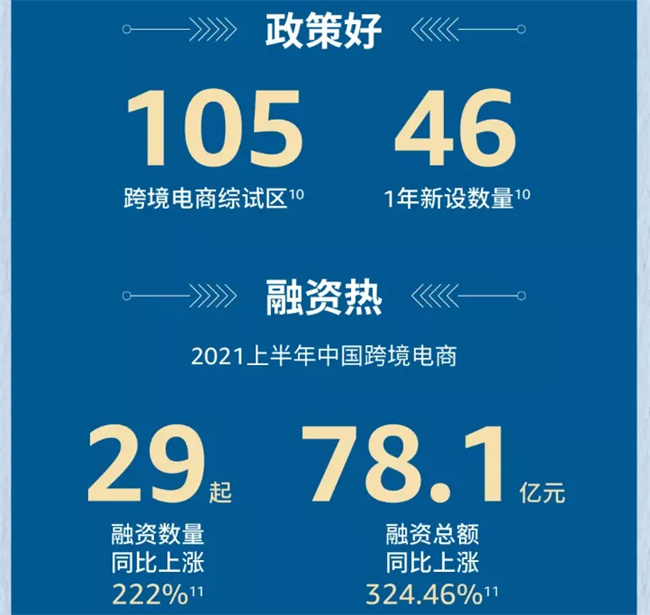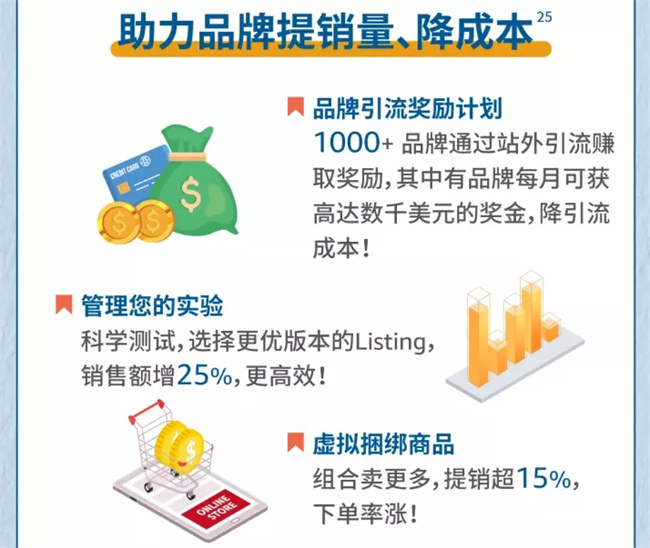In the last month of 2021, the performance of each e-commerce company has basically been finalized, and data reports from major e-commerce platforms will be released one after another. Today we have released the data. How big is the gold mine of cross-border e-commerce?
Global market space is $4.89 trillion
According to Amazon data, there are 2.14 billion online buyers worldwide in 2021, while the global e-commerce scale is expected to reach US$4.89 trillion, and global online sales are expected to reach US$5.55 trillion in 2022. This data accounts for 21% of the global retail sales, nearly twice the scale of China's retail e-commerce.

It also predicts that the annual sales of e-commerce in several other countries will exceed US$1 trillion, Japan will exceed US$100 billion, and the five European countries will exceed US$500 billion.
In addition to these mature sites, some emerging sites have emerged. The growth rate of e-commerce in the Middle East is the world's largest. The transaction scale is expected to reach US$48.6 billion in 2022, the user scale in India is the world's second, and it is expected to reach 890 million in 2024.

The scale of e-commerce in Australia is expected to reach US$32.3 billion in 2024, and the annual sales scale of e-commerce in Singapore is expected to reach US$8.6 billion in 2023.
China's cross-border e-commerce is booming
At the beginning of 2021, when facing the media, Minister of Commerce Wang Wentao introduced the situation of accelerating the high-quality development of business and serving the construction of a new development pattern. He revealed that after the epidemic, new forms and models of foreign trade have played an important role, such as cross-border e-commerce and market procurement trade methods.
In 2020, the import and export of cross-border e-commerce reached 1.69 trillion yuan, an increase of 31.1% year-on-year, while market procurement exports in 2020 were 704.54 billion yuan, an increase of 25.2%, both of which were double-digit rapid growth. Wang Wentao also said that he would further expand support for cross-border e-commerce and market procurement because they have strong vitality.
Further data is that among the 1.69 trillion yuan cross-border e-commerce import and export business, export business alone increased by 40.1%, which is about 10 times the overall growth rate of China's exports during the same period.
In 2020, China added 46 new cross-border e-commerce comprehensive pilot zones, with the total number expanding to 105, and 46 newly set up within one year. At present, more than 330 industrial parks have been built in various cross-border e-commerce comprehensive pilot zones, driving more than 3 million jobs. According to statistics, the number of overseas warehouses of cross-border e-commerce in China has exceeded 1,800, with a growth rate of 80% in 2020 and an area of more than 12 million square meters.

In the first half of this year, 29 cases of cross-border e-commerce in China received financing, an increase of 222% year-on-year, and the total financing amount reached 7.81 billion yuan, an increase of 324.46% year-on-year. Data predicts that by 2023, the overall scale of export e-commerce transactions will exceed 9 trillion yuan. In the past two years, the country has also continuously introduced favorable policies for cross-border e-commerce, which shows the prospects of cross-border e-commerce.
New way out for domestic e-commerce: cross-border e-commerce
After the epidemic, many voices on the Internet asked whether cross-border e-commerce is worth planning, and the answer is yes! Why? Because cross-border e-commerce has national support within and dividends of the times.
The so-called internal state support means that the country continues to introduce some favorable policies, and it is available every year. Taking Guangdong as an example, the province strives to build 500 overseas positions for cross-border e-commerce in 2025, and strives to achieve 20 companies with annual transaction scale of more than 5 billion yuan, 10 companies with more than 10 billion yuan, and 5 companies with more than 20 billion yuan. At the same time, we strive to build 20 "industrial clusters + cross-border e-commerce" pilot projects, cultivate 100 cross-border e-commerce sellers with annual transaction volume of more than 100 million yuan, and cultivate 100 cross-border e-commerce independent brands with annual sales of more than 100 million yuan.

There are dividends of the times, mainly referring to the e-commerce coverage rate of overseas countries. Compared with the domestic e-commerce coverage rate, overseas markets have just started and have been boosted by the epidemic, so overseas consumers' purchasing habits have undergone great changes.
The first change is to care about the earth. Among the consumers aged 18 to 55 in the United States, 71% are more concerned about environmental protection and sustainable development than a year ago, which is reflected in clothing, beauty and outdoor sports products.
The second change is to love online shopping more. The global average online consumption time has increased by 47%, 57% of consumers have become more dependent on online shopping, and 60% of consumers are more willing to try new brands.
The third change is that it is even more inseparable from mobile phones. This year, 62.2% of traffic and 44.4% of sales come from mobile phones, an increase of 10.6% over last year. It is expected that consumers of all ages in the United States will become head-downers in 2025.
The fourth change is that we love online social networking more. In terms of crazy shopping for social e-commerce, China is 46.4%, the United States is 35.9%, and Australia is 30.3%. By 2022, annual sales of social e-commerce in the United States are expected to grow by 24.9%, reaching US$45.74 billion.
The era of cross-border e-commerce brands has arrived
Judging from the data, the number and size of cross-border e-commerce brands, as well as the brand awareness of Chinese sellers are rising year by year, and branding can no longer be seen. 69% of global consumers believe that the development of Chinese brands is promising in the future. 93% of Chinese sellers said that it is very important to establish a brand on Amazon, and the number of Chinese brands entering Amazon has exceeded 10 times in three years.
In the first half of 2021, sales of brand sellers on Amazon's US site increased by nearly 60% year-on-year. Therefore, the Amazon platform is also striving to support the rapid growth of cross-border brands. Last year, Amazon invested more than 18 billion US dollars to help the development of small and medium-sized enterprises. At the same time, it developed more than 250 Amazon brand advantage tools to help sellers build good brands and sell good goods, such as buyer interaction, A+ pages, brand flagship stores, posts, buyer comments, etc.
Since the storm of cross-border e-commerce has been blowing, you have also seen it. Instead of being trapped in domestic e-commerce, you will decide to try cross-border e-commerce. Are you ready to all in?






![#Laogao E-commerce Newsletter# [E-commerce Evening News on April 22]](/update/1619084583l979251094.jpg)



 EN
EN CN
CN
